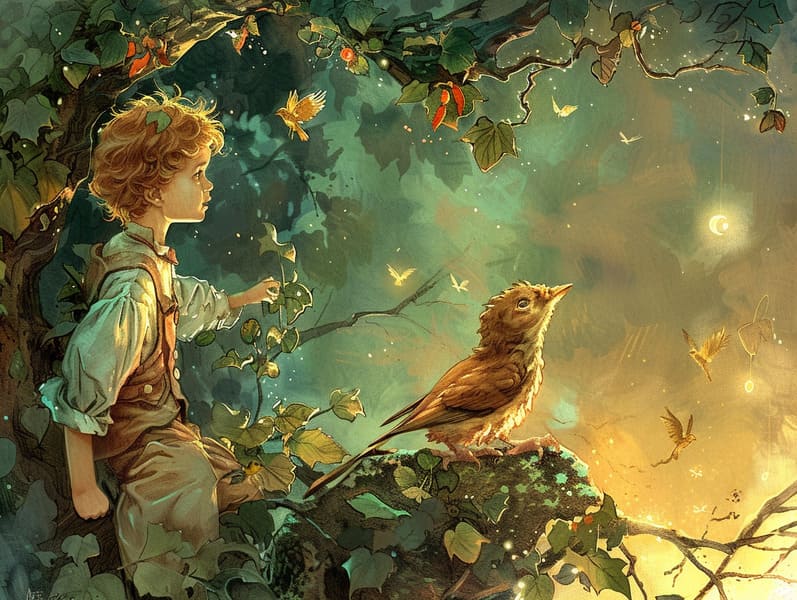
Traditional fairy tales have enduring presence. These narratives have been conveyed from one generation to the next far before they were ever written down. They sprang from a variety of cultures, including Western traditions. They were initially transmitted among elders, often carrying themes and messages reflective of the societal norms and beliefs of the time.
The renowned Brothers Grimm, Jacob and Wilhelm (the Grimm brothers), were among the first to compile many of these beloved stories. Their collection, "Grimm's Children's Stories," included tales like "The True Bride," "The Bread Crumb Trail," and "Snow-White and Rose-Red," which have since become classics in the world of classic fairy tales. Similarly, H. C. Andersen's magical fairy tales, such as "The Mermaid's Tale," and "The Duckling that Could," have captivated hearts worldwide, establishing their place in the pantheon of timeless fairy tales.
Though they are old, fairy tales remain as meaningful as ever, especially as kids' bedtime tales. These whimsical stories are now available in various formats, including artistically illustrated books, enchanting animations, and online fairy tales.
Their lasting presence can be traced to several enchanting factors:
Life Lessons: Old fairy tales often provide important moral lessons. Tales like "The Tale of the Boy Who Cried Wolf" teach the merit of sincerity, while "The Race of the Tortoise and the Hare" demonstrate the virtues of steadfastness and humility. These narratives offer the young clear distinctions between right and wrong, molding their moral compass in a subtle yet important way.
Compassion and Knowledge: Traditional fairy tales frequently portray beings facing challenges and struggles, inciting young readers to comprehend with their struggles and back their triumphs. For instance, "Beauty and the Beast" illustrates the merit of seeing beyond the surface to recognize the real person of a individual, cultivating understanding and perception.
Cultural Recognition: Many classic fairy tales are saturated in the cultural contexts from which they originated. Exploring these tales can provide captivating looks into different historical contexts, fostering a sense of cultural awareness and appreciation.
Creativity and Imagination: The enchanted elements in classic fairy tales—enchanted forests—fire up children’s creative dreams. These narratives move readers to extraordinary realms, enlivening imaginative thinking and a sense of excitement that remains a lifetime.
Traditional fairy tales are not only captivating but also enlightening. They act as alluring tools in fostering various cognitive and affective skills in the young. When ancient fairy tales are recited, they enhance communication skills by introducing new lexicon and complex sentence structures. This practice also improves auditory perception and attention span, as young readers listen intently, eager to see what happens next.
Furthermore, conversing about the themes and characters of timeless fairy tales can advance reasoning skills and evaluative skills. Children are led to discover patterns, make predictions, and catch on to cause and effect. These conversations also boost children utter their thoughts and feelings, advancing their emotional intelligence.
In today’s online age, the abundance of internet fairy tales has made these narratives more accessible than ever. Internet resources and software offer vast collections of old fairy tales that can be experienced or listened via anytime, anywhere. Fairy tales voiced are particularly liked, making available an enjoyable way for the young to experience these delightful tales. Spoken stories and read-out-loud videos lead characters and settings to life, often accompanied by fantastical audio effects and instrumentals that raise the storytelling experience.
The timeless allure of old fairy tales lies in their ability to transform to the present while maintaining their core values. Contemporary versions of these stories often include more representative characters and modern settings, making them understandable to today’s audience. However, the core values of heroism, charity, and truth remain unchanged, continuing to connect with kids of all ages.
Ancient fairy tales also offer a sense of serenity and knowability. They confer upon a well-ordered narrative with a transparent beginning, middle, and end, often coming to a close with the settlement of conflicts and the triumph of good over evil. This regularity can be comforting for young readers, making known a sense of sturdiness in an always check it out shifting world.
Timeless fairy tales continue to charm and enlighten new generations, maintaining their majesty and importance in modern society. As kids' bedtime tales, they make available a perfect blend of charm and enlightenment, encouraging moral values, empathy, and creativity. The prevalence of online storybooks and the likability of fairy tales recited confirm that these timeless tales remain reachable to new generations.
By continuing and recounting these fairy tales, we continue to pay tribute to the rich tapestry of inventiveness and cultural heritage. Whether you are viewing a beautifully illustrated book, accessing a web-based collection, or listening on an audio story, the attraction of Grimm's fairy tales is always within reach. These tales emphasize of the immortal power of storytelling and its ability to gather us across centuries and lands.
Whether you are enjoying a vibrantly illustrated book, enjoying a digital collection, or listening via an read-aloud book, the magic of old fairy tales is always within reach.
These narratives remind us of the everlasting ability of narratives and its ability to unite us across epochs and places, establishing a link that captivates and teaches alike.